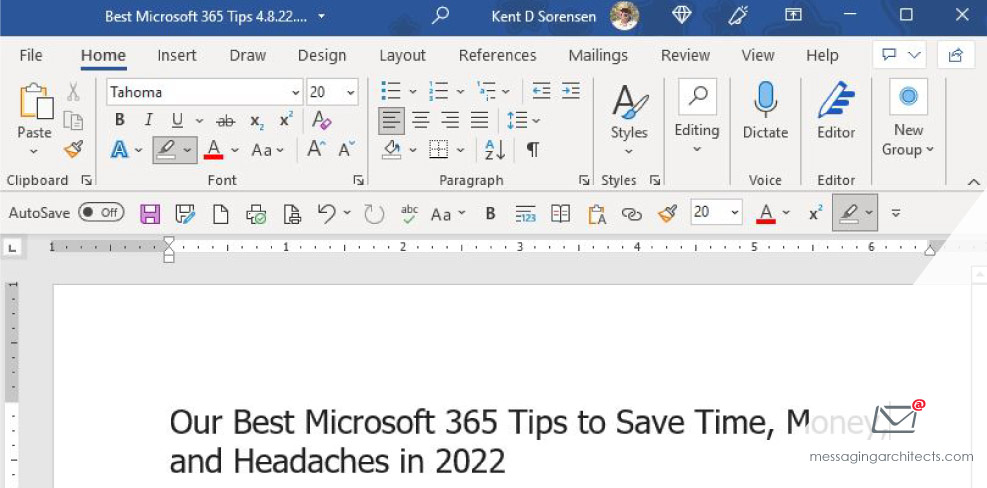The productivity and security experts at Microsoft know from experience the need to work smarter, faster, and more securely. They continually build productivity and security features into their products while improving existing options. Keeping up can be a challenge. Hence, we’ve assembled our best Microsoft 365 tips to save time, money, and headaches.
In addition to productivity tips, we’ve included pointers relating to Microsoft 365 mailboxes and related tools. And having heard horror stories about failed cloud migrations, we must also recommend careful preparation for Microsoft 365 migrations. Finally, knowing they are essential for business success, we can’t ignore Microsoft 365 backups.
1. Set Up Distribution Groups to Streamline Communications
Distribution groups provide a streamlined way to send email to a list of recipients with more functionality than a simple distribution list. There is a mailbox associated with the Distribution Group and all mail will be sent to that address.
Members have access to this mailbox like a shared mailbox or can receive a distributed copy automatically to make it function more like a distribution list. Other features allow administrators to restrict the access and visibility of this Group to non-members or external senders.
In addition, Distribution Groups in Microsoft 365 can be self-managed allowing self-add or self-remove. Or you can designate the owner of that Group to authorize the action.
Distribution groups may include both internal and external members. For example, you could create an internal group including all employees in a department. You could also create an external distribution group for customers who sign up for the monthly sales newsletter.

2. Personalize Menus to Speed Access to Frequently Used Features
Instead of spending time trying to remember where to find an often-used feature, personalize menus to match how you work. Microsoft 365 apps allow users to customize the Ribbon, or top menu. Simply go to File>Options and click Customize Ribbon. Then add or remove features as desired. You can also change the order of items and even rename them.
In addition, users can customize the Quick Access Toolbar at the top of the document. The default options include shortcuts such as AutoSave, Save, Undo and Redo. Click the down arrow to the right of the Quick Access menu to add almost any command to your shortcuts.
3. Create Microsoft 365 Mailboxes for Scheduling Resources
Resource mailboxes facilitate scheduling for physical locations or equipment, such as conference rooms. They provide a wide range of options for self-management allowing auto-acceptance or manual acceptance. They also offer additional parameters governing length of meetings, priority groups, or time restrictions to avoid commandeering the meeting room through auto-acceptance.
Simply create an email address for the room or piece of equipment as if it were an actual person. Then add the resource email to a calendar item or meeting request in Outlook to reserve it for that time slot.

4. Share Documents Quickly
Microsoft 365 apps allow users to share documents without leaving the app. If the document has been saved to OneDrive, you can send either a link or a copy. When sending a link, Share includes the option to add an expiration date and password. And when sending a copy, users can send either the document in original format, such as Word, or as a PDF.
To share a document, simply click the Share button (the box with an arrow) in the upper right corner. Then select the desired options from the dialog box that appears.
5. Reduce ROT Before Any Microsoft 365 Migration
Like any moving process, migration presents an opportunity to remove junk, rather than simply moving it to the new location. Look for redundant, obsolete and trivial (ROT) data in the old system. Determine what data you can safely delete and what data needs to move to an archive. Moving only relevant data to the new system will save time, money, and headaches.
6. Implement Data Backup in Microsoft 365
Backups represent a critical piece of business continuity. And, while Microsoft takes steps to protect your data, the responsibility for data backups rests largely on the customer organization. With careful planning, businesses can ensure that accidental deletion of a folder or even a ransomware event will not cause major disruption.

7. Identify the Critical Microsoft 365 Business Data to Back Up
Microsoft 365 includes a host of tools for collaboration, which store data in a variety of locations. For instance, users keep and share documents through SharePoint and OneDrive. Outlook mailboxes contain thousands of emails and appointments. And Teams stores chats and voicemails for future reference.
The organization will need to determine how much of this data requires backup and how often to run backups. This varies, depending on business needs, industry regulations and applicable legislation, such as HIPAA.
Best Microsoft 365 Tips from the Experts
The Microsoft 365 information governance experts at Messaging Architects deliver the tools and expertise to help organizations increase productivity and safeguard critical business data. They assist business and IT leaders with optimal configuration of Microsoft 365, identifying important data, and implementing features to get the most from this amazing product.







